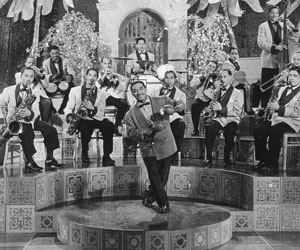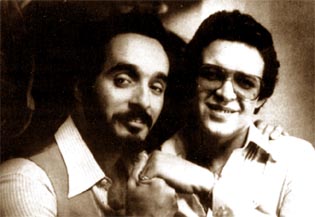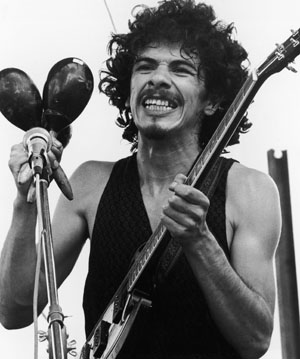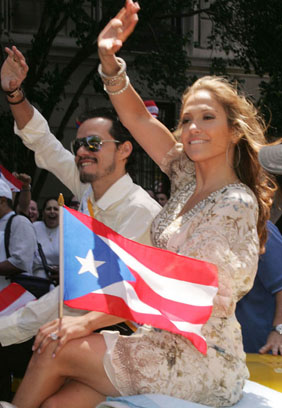Latin Music USA, BBC Four | reviews, news & interviews
Latin Music USA, BBC Four
Latin Music USA, BBC Four
Definitive documentary series packed with rare footage.
Latin Music USA is a long-overdue exploration of the Latino influence on American popular music. The four-part BBC Four Friday-night series zooms in on the bicultural American populations rooted in Cuba, Puerto Rico and Mexico, but living in their original entry points, Miami, New York, LA and the Tex-Mex border. The series examines the lifestyles and politics behind the music and their impact in the US beyond Spanish-speaking neighbourhoods. “Each programme looks and feels different, matching the cultures,” explains the London director, Jeremy Marre. In the early days, the Cubans and Puerto Ricans were absorbed as New Yorkers, but on the West coast the Mexicans were still called "shit-kickers".
This compelling, educational, danceable series was initiated and produced in London and co-produced with PBS America. Their version is nearly 15 minutes shorter as a result of cuts made to "soften" the social and political content; anything associated with post-Castro Cuba, it seems, still demands censorship. But both productions benefit from copious live performances, interviews with legends past and present, and with local journalists. Most irresistible is the lavish archive footage which, the director says, accounts for almost 50 per cent of the overall content and includes gems unearthed in lofts and cupboards.
The programmes divide geographically and by nationalities, regions chosen to highlight where the immigrant music mutates, “Places where music was transformed,” says Jeremy Marre, “where strands coming in evolved into something else in that new society. And that reflects the pressures and conflicts of people integrating into the US.”
In the opening episode, East Side Story, Puerto Ricans and Cubans are the central characters. West Side Story gets obvious attention, and whilst the New York writer Ed Morales admits that “no-one could deny its impact - it put Puerto Ricans on the map,” he adds derisively, “But the characters were played by Italians and Greeks!”
 The massive 1930s influx of rural Puerto Ricans into New York created Spanish Harlem, and the trickle of Cubans who also arrived then included musicians there for the jazz.Among them was the late Mario Bauza who adds first-hand back-stories about the mambo. A trumpeter with Cab Calloway, he was saxophonist and co-founder of Machito’s Afro-Cubans (picture left) which co-launched mambo USA-style at the Palladium Ballroom on 52nd Street. Acrobatic, proto-break-dancing mambonik performances are favourites in any TV programme about vernacular dance, but here there’s also the zoot-suited eccentric genius, Perez Prado, who sent Americanized hits like Mambo #5 around the world.
The massive 1930s influx of rural Puerto Ricans into New York created Spanish Harlem, and the trickle of Cubans who also arrived then included musicians there for the jazz.Among them was the late Mario Bauza who adds first-hand back-stories about the mambo. A trumpeter with Cab Calloway, he was saxophonist and co-founder of Machito’s Afro-Cubans (picture left) which co-launched mambo USA-style at the Palladium Ballroom on 52nd Street. Acrobatic, proto-break-dancing mambonik performances are favourites in any TV programme about vernacular dance, but here there’s also the zoot-suited eccentric genius, Perez Prado, who sent Americanized hits like Mambo #5 around the world.
The Cuban element includes monochrome footage of Havana in its glamorous 1950s pre-Castro Guys and Dolls days, when the city was irresistible to visitors and Sinatra glides through a casino where the future Queen of Salsa Celia Cruz (pictured below right) is singing to American tourists. The unrivalled Latin diva, Cruz makes appropriately frequent appearances in the programme, but sadly no interviews. Still, on the launch night of the BBC series, after a Barbican concert of mambo led by the musician sons of Tito Puente and Machito and some leading salsa notables, the evening closed with a showing (also on BBC Four) of the 1986 Arena documentary, My Name is Celia Cruz. Having been part of its tiny production team myself, it was a night of memories, sadness and inspiration, but also a significant reminder to viewers unfamiliar with her singing or personality, of her astonishing charisma, vocal power and virtuosity. There is no questioning her right to the often over-used title of Diva.
Below Celia Cruz sings 'Pinar del Rio' in 1960:
Programme 2, Salsa, is obviously devoted to the now international dance, launched from New York in the 1970s. A decade earlier, when the late Celia Cruz and many other legendary musicians were settling into the music scene in their new home town, there was also a political agenda as Puerto Ricans allied with the Civil Rights movement and founded their own Black Panther equivalents, the Young Lords (an interesting story barely touched on here). The simultaneous emergence of the boogaloo style also reflected that close relationship between Latinos and neighbouring black Harlemites in the boogaloo blend of soul and Afro-Cuban music, Spanish and English lyrics, and a rocking American beat.
For many serious older musicians including Johnny Pacheco, the legendary producer of the most significant salsa records in existence, boogaloo was musically unsophisticated kids’ play. “I hated boogaloo!” he laughed derisively into the camera. But for first-generation NuYoricans like the future salsa star, Willie Colon and poet and first Chairman of the New York branch of the Young Lords, Felipe Luciano, it created a soundtrack matching their lives.
Luciano recalls his dissatisfaction with the "old-fashioned" stuff: "I wanted a raw, more monochrome music, a less colourful, more face-to-face solution.” The answer came via the pianist Eddie Palmieri’s original, stomping, two-trombone line-up eponymously called La Perfecta. Willie Colon ran with the idea through the barrio and created his own tough, urban sound, described by Luciano, as “an act of hypnotic civil disobedience”.
 As the fad faded, sophistication returned and everything focused on Fania Records, the label equivalent to Motown. In interviews with familiar salsa legends, some refreshingly honest reflections emerge about that era: the still debonair Pacheco is unusually confident in expressing his bitterness toward his dodgy late partner Jerry Masucci, Fania's co-founder. Willie Colon and the equally iconic Ruben Blades discuss the role of politics in their music (both now inhabit political realms). And in a hauntingly moving sequence about the greatest male singer of salsa, Hector Lavoe, his friend and first band leader Colon openly condemns managers and fellow musicians for providing the drugs that led to his HIV/AIDS death (the pair pictured right in 1973).
As the fad faded, sophistication returned and everything focused on Fania Records, the label equivalent to Motown. In interviews with familiar salsa legends, some refreshingly honest reflections emerge about that era: the still debonair Pacheco is unusually confident in expressing his bitterness toward his dodgy late partner Jerry Masucci, Fania's co-founder. Willie Colon and the equally iconic Ruben Blades discuss the role of politics in their music (both now inhabit political realms). And in a hauntingly moving sequence about the greatest male singer of salsa, Hector Lavoe, his friend and first band leader Colon openly condemns managers and fellow musicians for providing the drugs that led to his HIV/AIDS death (the pair pictured right in 1973).
But all regrets and resentments vanish when the screen fills with the Fania All Stars’s ecstatic, virtuosic performances and crowds wave flags representing Puerto Rico and Cuba, countries they mostly know about from their parents. A highlight of the Fania section is the recently unearthed amateur film taken during the flight to Kinshasa for the Rumble in the Jungle concert featuring the Fania All Stars and James Brown. Celia Cruz, elegant as ever, is squashed up amongst her musicians, her husband Pedro and johnny Pacheco laughing raucously, tapping a rhythm with one hand and waving a pistol in the air with the other.
Covering the same eras, programme 3, Borderlands, shifts to Chicano California and the Tex-Mex border zones. Probably the least-documented story in the series (at least in this country), it offers an enlightening history and demolishes lasting stereotypes of Mexican culture through interviews and performances by several of the hugely successful, multi-Grammy arist-superstars. The singer Linda Ronstadt frames the story, explaining, “The history of Mexican America is necessarily the history of the migrations up from Mexico.”
Early scenes illustrate the vast numbers of underpaid migrant farm workers struggling to survive, and then we meet the one who got away; a 17-year-old singer called Richard Valenzuela who reinvented himself as Ritchie Valens and was nicknamed "the Mexican Elvis". His astonishing international success with his song La Bamba, created the first Mexican pop star, but his shocking death in Buddy Holly’s plane crash meant he never knew if his hit was a fad or genuine integration into American music.
Below Ritchie Valens sings 'La Bamba' on youtube:
Forty years on, Carlos Santana (pictured below right) transfixes a hippy Woodstock audience with his American guitar, Cuban congas and a song called Oye como va by the Puerto Rican-New York Mambo King, Tito Puente. The first Mexican rock star, Santana nevertheless remains musically apart from the Mexican-American Grammy-winners we see performing tear-jerking corrido ballads, mariachi and Tex-Mex (tejano) - songs about love and loss, life's daily trials and themes around political campaigns.
 Alongside the global success of Ritchie Valens and Santana, several generations of singers have become figureheads for Mexican-Americans. Multi-Grammy winners Little Joe (Hernandez) and Freddie Fender (Baldemar Huerta) both escaped from farm-work into song, and became icons through traditional songs interwoven with rock, jazz and country music, and lashings of high emotion from voices and accordions. Little Joe supported the 1960s “Right to be Mexican-American” campaign during civil unrest and Chicano demonstrations in California.
Alongside the global success of Ritchie Valens and Santana, several generations of singers have become figureheads for Mexican-Americans. Multi-Grammy winners Little Joe (Hernandez) and Freddie Fender (Baldemar Huerta) both escaped from farm-work into song, and became icons through traditional songs interwoven with rock, jazz and country music, and lashings of high emotion from voices and accordions. Little Joe supported the 1960s “Right to be Mexican-American” campaign during civil unrest and Chicano demonstrations in California.
The super-eclectic King of Tejano music, the late Freddie Fender, who reinvented himself as a Country singer (with a Mexican twang), describes how crossing the musical border into Nashville was easier than getting into the USA. In the 1970s Los Lobos shared a rock passion with Santana but their songs were accompanied by traditional bajo sexto guitars and returned to the roots. And Linda Ronstadt’s surprising (and gorgeous) 1988 album Canciones de mi padre, replaced her rock image with songs her father sang, and substituted rock-chick dresses for a glittery mariachi suit.
Inspiration may have come from Los Tigres del Norte (see main photo), whose dazzling costumes are similarly badges of honour and whose songs are an infectious combination of rock, mariachi and corridos. In their filmed performance, The Tigers radiate the energy of songs rooted deep inside a turbulent culture. The Mexican programme inevitably includes the story of the sensational success and tragedy of Selena, the 23-year-old singer who sold six million copies of her version of Gloria Gaynor’s I will Survive, and was shot dead by the President of her fan club. In 1997 the Latin world’s newest superstar, Jennifer Lopez, immortalized her in the biopic Selena.
In the concluding programme, The Latin Explosion, the focus is Miami, "the Nashville of Latin Music," says Miami Herald writer, Jordan Levin. Gloria and Emilio Estefan are rightly centre-stage, crucial players in the transformation of the rundown city into a modern Latin American capital, a glittering, wealthy, cultural and business centre. Starting out as 1960s Castro exiles, the Estefans grew to live the American dream. But for the 125,000 Cuban Marielitos who landed in Miami in 1980, climbing the ladder was never easy. Plus their arrival coincided with the Colombian cocaine wealth which largely helped rebuild the city and led to its relatively short-lived image-change - as we see in irresistible extracts from Scarface and Miami Vice.
 While Gloria Estefan took the Miami Sound around the globe, Emilio was the must-have Latino record producer; his most successful follow-up to his wife was the singer whose name is now almost a brand, Shakira. We follow the dark-haired Colombian''s first experience in Estefan’s studio through to the full-on Americanization of her image. A female journalist asks, rhetorically, “Does it take becoming blonde to become a star in America?” But just as Estefan proves he has the nose, so Shakira has revealed talent and intelligence. Like Shakira, the latest royal Latinos aren’t Miami folk but NuYoricans. Jennifer Lopez and Marc Anthony riding down Fifth Avenue (pictured right), waving the national flag on the Puerto Rican Day parade, are models of integrated Latino-Americans who dip in and out of their roots as they please.
While Gloria Estefan took the Miami Sound around the globe, Emilio was the must-have Latino record producer; his most successful follow-up to his wife was the singer whose name is now almost a brand, Shakira. We follow the dark-haired Colombian''s first experience in Estefan’s studio through to the full-on Americanization of her image. A female journalist asks, rhetorically, “Does it take becoming blonde to become a star in America?” But just as Estefan proves he has the nose, so Shakira has revealed talent and intelligence. Like Shakira, the latest royal Latinos aren’t Miami folk but NuYoricans. Jennifer Lopez and Marc Anthony riding down Fifth Avenue (pictured right), waving the national flag on the Puerto Rican Day parade, are models of integrated Latino-Americans who dip in and out of their roots as they please.
Miami today epitomizes the Latinization in the USA: Spanish and Spanglish its languages, and Latino its dominant population, cafe con leche its choice over capuccino. Wrapping up the series, the film engages with corporate America, particularly the Latin music industry centred on Miami. It homes in, logically, on reggaeton, the latest youth sensation, a reggae/ragga/rap hybrid born in San Juan, Puerto Rico, and boasting Spanglish vocabulary and Grammy-winning superstars including Pitbull and Daddy Yankee, who live between the US and the island.
Jeremy Marre points to similarities between the reggaeton pioneers and proto-salsa bands like Willie Colon's: “It’s back to the streets,” he says. “First of all, they are Puerto Ricans; at home their parents would listen to the Fania salsa records, and like those musicians, they see themselves as an extension of their culture. They all wanted to talk to me about Willie Colon, Ruben Blades and Hector Lavoe: reggaeton is reclaiming the music for the streets, because by the 1990s (when reggaeton evolved from Latin hiphop), salsa had become a very different, mainstream animal. Reggaeton’s taken it back to the barrios. Proof of that is the sight of Daddy Yankee wearing a T-shirt printed with the sleeves of one of Willie Colon’s records from his Bad Boy street days.
Reggaeton may have emerged from Puerto Rico, but its business is focused in Miami, the city which also houses Ricky Martin and his. In contrast to reggaeton's wilful originality and independence, the enduring heart-throb and seriously great performer is increasingly moving towards being the face of corporate America. As the multi-nationals search for appropriate icons to head their Latino campaigns, the film runs us through the Ricky story, from his launch with the Puerto Rican boy-band Menudo to his recent signing for a Pepsi campaign. The subtext is clear: when Ricky drinks Pepsi, Pepsi becomes Latino. Marre’s concluding words seem unarguable: “It’s estimated that by 2050, 25 per cent of all American youth will be Latino. And corporate America is already gearing up to that huge new market.”
Below: Ricky Martin performs 'Fuego de noche nieve de día' on youtube:
- Watch the BBC i-Player reruns of all four episodes until next Friday (25 February)
- Sue Steward's Salsa! Musical Heartbeat of Latin America (Thames & Hudson) has a foreword by Willie Colon.

Add comment